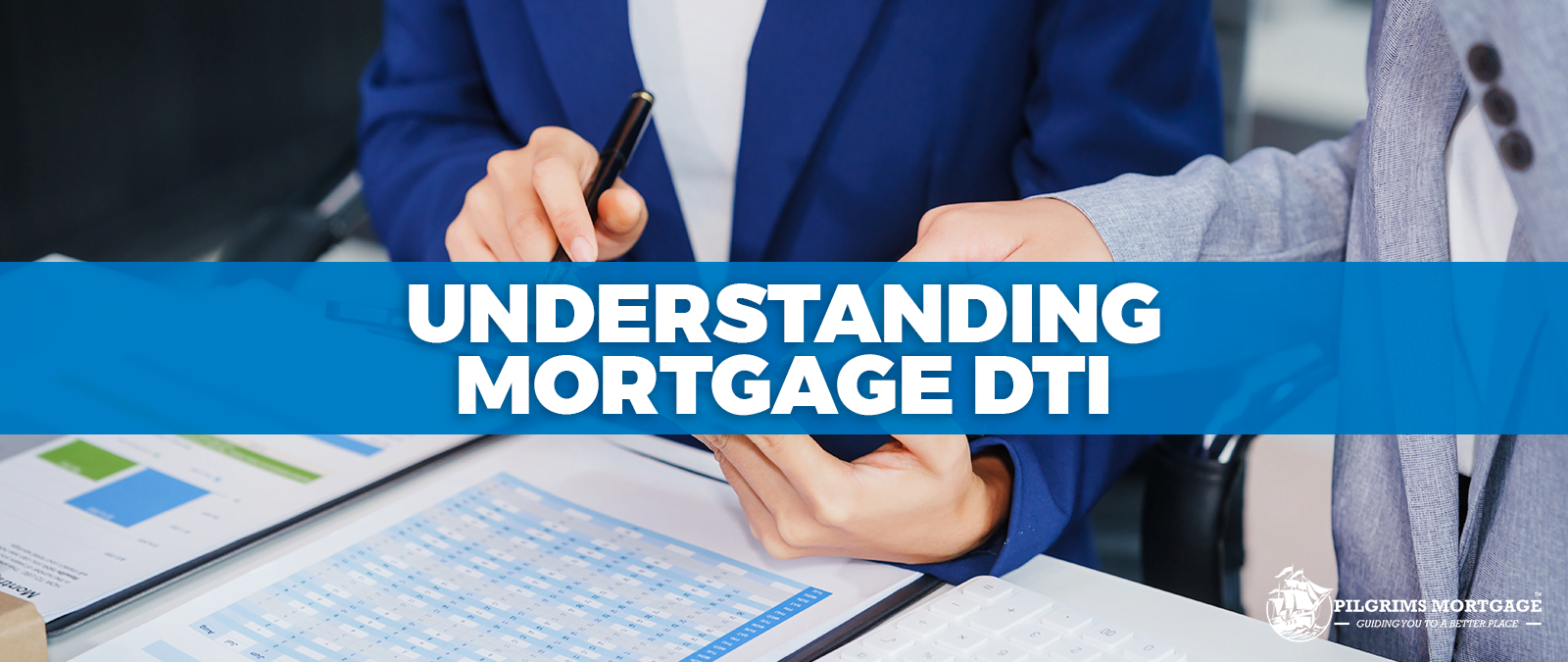In this article, we’ll delve into how mortgage DTI is calculated, its significance, and what it means for your homebuying journey. When applying for a mortgage, lenders consider several factors to determine your creditworthiness and ability to repay the loan. One crucial aspect is your debt-to-income (DTI) ratio, which measures your monthly debt payments against your gross income. What is Mortgage DTI? Mortgage DTI is the percentage of your monthly gross income that goes towards paying debts, including the proposed mortgage payment, other loans, credit cards, and minimum payments on revolving debts. Lenders use this ratio to assess your ability to manage your debt burden and ensure you’re not overextending yourself. How is Mortgage DTI Calculated? To calculate your mortgage DTI, lenders follow these steps: For example: Gross income: $5,000 per month Total monthly debt payments: $2,500 DTI calculation: ($2,500 ÷ $5,000) x 100 = 50% In this scenario, your mortgage DTI is 50%, indicating that half of your gross income goes towards debt repayment. Why Does Mortgage DTI Matter? Lenders consider DTI a critical factor in mortgage approval because it reveals your ability to manage debt and make timely payments. A high DTI ratio may indicate overextension, increasing the risk of default. Generally, lenders prefer a DTI ratio of 45% or less, although some may accept higher ratios depending on compensating factors like a high credit score or substantial assets. Tips to Improve Your Mortgage DTI If your DTI ratio is higher than desired, consider these strategies: Conclusion Understanding mortgage DTI is essential for homebuyers and homeowners alike. By grasping how lenders calculate this ratio and maintaining a healthy DTI, you’ll improve your chances of securing a favorable mortgage deal and ensuring a sustainable financial future. Remember, a lower DTI ratio can lead to better loan terms, lower interest rates, and a more secure financial footing.
Mortgage interest rates are a crucial aspect of the homebuying process, as they can significantly impact the overall cost of your loan. While many factors influence mortgage interest rates, some have a more significant impact than others. In this article, we’ll explore the key items that affect mortgage interest rates and provide valuable insights to help you make informed decisions when navigating the mortgage landscape. Economic indicators such as inflation, gross domestic product (GDP), and employment rates play a significant role in shaping mortgage interest rates. When the economy is strong, and inflation is high, interest rates tend to rise to combat inflationary pressures. The Federal Reserve, the central bank of the United States, has a profound impact on mortgage interest rates. The Fed sets short-term interest rates, which influence long-term rates like mortgage rates. When the Fed raises or lowers short-term rates, it can impact mortgage rates. Mortgage-backed securities (MBS) are traded in the bond market, and their prices influence mortgage rates. When demand for MBS increases, prices rise, and mortgage rates fall. Conversely, when demand decreases, prices fall, and mortgage rates rise. Global events like political instability, wars, or natural disasters can impact mortgage interest rates. During times of uncertainty, investors seek safer investments like bonds, driving prices up and mortgage rates down. Lender competition also plays a role in shaping mortgage interest rates. When lenders compete for business, they may offer lower rates to attract customers. Loan terms like loan-to-value (LTV) ratio, credit score, and loan duration impact mortgage rates. Borrowers with lower LTV ratios, higher credit scores, and shorter loan terms may qualify for lower interest rates. The type of property you’re purchasing or refinancing also affects mortgage interest rates. Rates for primary residences are often lower than those for investment properties or second homes. Borrowers can pay points and fees to lower their mortgage rates. This can be a cost-effective strategy for those planning to keep their loan for an extended period. Government-backed loans like FHA and VA loans often offer lower interest rates than conventional loans due to the government’s guarantee. Mortgage interest rates can be influenced by seasonal factors like summer and winter fluctuations in housing demand. In conclusion, mortgage rates are influenced by a complex array of factors. Understanding these items can help you make informed decisions and potentially secure better loan terms. Remember to shop around, consider multiple lenders, and carefully evaluate loan terms to find the best mortgage option for your circumstances.
There’s an alternative financing option that’s gaining popularity among real estate investors: DSCR (Debt Service Coverage Ratio) financing. When it comes to real estate investing, financing is a crucial aspect to consider. Traditional mortgage options often require a significant down payment and strict credit requirements, making it challenging for investors to secure funding. What is DSCR Financing? DSCR financing is a type of mortgage that uses the property’s cash flow to determine the borrower’s ability to repay the loan. Unlike traditional mortgages that focus on the borrower’s personal income and credit score, Debt Service Coverage Ratio financing considers the property’s income-generating potential. This approach allows investors to qualify for a mortgage based on the property’s cash flow, rather than their personal financial situation. How Does DSCR Financing Work? To qualify for Debt Service Coverage Ratio financing, the lender calculates the property’s debt service coverage ratio by dividing the net operating income (NOI) by the annual debt service payments. The resulting ratio must meet the lender’s minimum requirement, typically ranging from .75 to 1. For example, let’s say you’re purchasing a rental property with a NOI of $50,000 per year. The annual debt service payments, including principal and interest, are $35,000. The Debt Service Coverage Ratio would be 1.43 ($50,000 ÷ $35,000), indicating that the property generates sufficient income to cover the mortgage payments. Benefits of DSCR Financing DSCR financing offers several benefits for real estate investors: Conclusion DSCR financing offers a unique approach to real estate financing, focusing on the property’s cash flow rather than the borrower’s personal financial situation. By considering the property’s income-generating potential, investors can secure funding for their real estate investments with easier qualification, higher loan amounts, lower down payments, and flexibility. If you’re a real estate investor seeking alternative financing options, DSCR financing is definitely worth exploring.
Adjustable-rate mortgages (ARM) have become increasingly popular in recent years, offering borrowers flexibility and potential savings on their mortgage payments. However, the complexity of ARM mortgages can be overwhelming, especially when it comes to understanding the indexes that determine the interest rate. In this article, we will delve into the commonly used indexes for ARM mortgages, explaining how they work and their impact on your mortgage payments. What are ARM Mortgages? Adjustable-rate mortgages are loans with interest rates that adjust periodically based on a specific index. The interest rate is typically tied to a benchmark index, plus a margin set by the lender. The initial interest rate is usually lower than fixed-rate mortgages, making ARMs attractive to borrowers who want lower monthly payments. Commonly Used Indexes for Adjustable-rate Mortgages LIBOR is one of the most widely used indexes for Adjustable-rate mortgages. It’s the average interest rate at which major banks borrow funds from each other in the London interbank market. LIBOR is calculated daily and is considered a benchmark for short-term interest rates. Treasury securities, such as the 1-year or 5-year Treasury bill, are another popular index for Adjustable-rate mortgages . These securities represent the borrowing costs of the US government and are considered a low-risk investment. The federal funds rate is the interest rate at which banks and other depository institutions lend and borrow money from each other. This rate is set by the Federal Reserve and has a significant impact on the overall economy. COFI is a weighted average of the cost of funds for savings institutions in the 11th Federal Home Loan Bank district, which includes Arizona, California, and Nevada. This index is commonly used for Adjustable-rate mortgages (ARMs) in Western states. The bank prime loan rate is the interest rate at which banks lend to their most creditworthy customers. This rate is influenced by the federal funds rate and is often used as a benchmark for ARM mortgages. How Indexes Affect ARM Mortgages When an ARM mortgage is originated, the lender sets the initial interest rate based on the chosen index, plus a margin. The margin remains constant throughout the life of the loan, while the index can fluctuate. As the index changes, the interest rate on the ARM mortgage adjusts accordingly. For example, let’s say you have an ARM mortgage with a 5-year Treasury bill index and a margin of 2%. If the 5-year Treasury bill rate is 2.5%, your initial interest rate would be 4.5% (2.5% + 2%). If the Treasury bill rate increases to 3%, your interest rate would adjust to 5% (3% + 2%). Conclusion ARM mortgages can offer flexibility and potential savings, but it’s essential to understand the indexes that determine the interest rate. By grasping how LIBOR, Treasury securities, the federal funds rate, COFI, and the bank prime loan rate work, you’ll be better equipped to navigate the complexities of ARM mortgages. Remember, the index you choose will impact your mortgage payments, so it’s crucial to select the one that aligns with your financial goals and risk tolerance. Always consult with a mortgage professional to determine the best ARM mortgage option for your situation.
Treasury securities are government-backed investments issued by the United States Department of the Treasury to finance its operations and pay off maturing debt. These securities are considered to be among the safest investments in the world, with a low risk of default. In this article, we will delve into the details of treasury security, their types, benefits, and how they work. What are Treasury Securities? Treasury securities are debt instruments issued by the US government to raise capital. They are backed by the full faith and credit of the US government, making them a low-risk investment. Treasury securities are used to finance various government activities, such as funding federal programs, paying off maturing debt, and managing cash flows. Types of Treasury Securities There are several types of treasury security, each with different maturity periods and interest rates. T-Bills are short-term securities with maturities ranging from a few weeks to a year. They are sold at a discount to their face value and do not pay interest before maturity. T-Notes are long-term securities with maturities between two and ten years. They pay interest semi-annually and return the face value at maturity. T-Bonds are long-term securities with maturities of 10 to 30 years. They pay interest semi-annually and return the face value at maturity. TIPS are designed to protect investors from inflation. The principal and interest payments are adjusted to keep pace with inflation, ensuring that the purchasing power of the investment is preserved. Benefits of Treasury security Treasury security offer several benefits to investors, including: Treasury security is backed by the US government, making it a low-risk investment. Treasury securities are highly liquid, with a large and active market. Interest earned on treasury security is exempt from state and local taxes. Treasury security provide a diversification benefit, as their performance is not directly correlated with stocks or corporate bonds. How Treasury Securities Work Treasury security is sold at auction to investors, who bid on the interest rate they are willing to accept. The auction process determines the interest rate and the price of the security. Investors can also purchase treasury security through banks, brokers, or online platforms. Conclusion Treasury securities are a safe and liquid investment option that offers a range of benefits to investors. Understanding the different types of treasury securities and their features can help investors make informed decisions about their investments. Whether you are a individual investor or a financial institution, treasury securities can provide a low-risk addition to your investment portfolio.
As a landlord, managing tenants on a 2-4 unit property can be a challenging task. However, with the right strategies and techniques, you can ensure a harmonious and profitable relationship with your tenants. In this article, we will provide you with valuable tips on how to manage tenants on a 2-4 unit property. Tip #1: Screen Tenants Thoroughly Before renting out your property, it’s essential to screen tenants thoroughly. This includes: Tip #2: Set Clear Expectations Setting clear expectations is crucial to avoid misunderstandings and conflicts with tenants. This includes: Tip #3: Maintain Open Communication Effective communication is key to a successful landlord-tenant relationship. This includes: Tip #4: Manage Finances Efficiently Managing finances efficiently is critical to ensure a profitable rental property. This includes: Tip #5: Handle Maintenance and Repairs Promptly Handling maintenance and repairs promptly is essential to keep tenants satisfied and avoid costly damages. This includes: Tip #6: Respect Tenant Privacy Respecting tenant privacy is essential to maintain a positive relationship. This includes: Tip #7: Stay Organized and Documented Staying organized and documented is crucial to manage tenants effectively. This includes: Conclusion on a 2-4 unit property Managing tenants on a 2-4 unit property requires effective communication, thorough screening, and efficient financial management. By following these tips, you can ensure a harmonious and profitable relationship with your tenants. Remember to stay organized, respect tenant privacy, and handle maintenance and repairs promptly to maintain a successful rental property.






